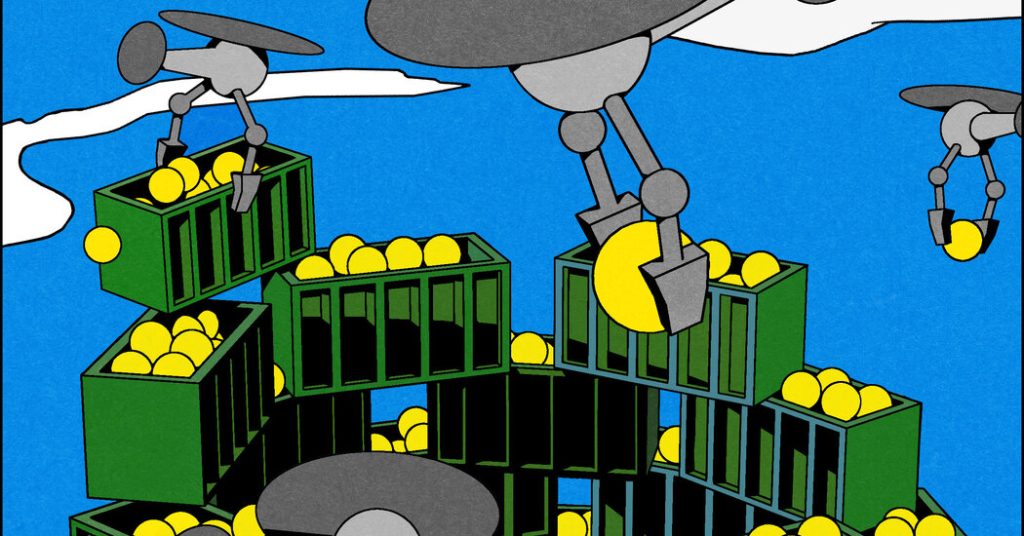The international trading system has failed America and many other countries around the world. No one has done more than President Trump to bring attention to this broad failure.
By imposing tariffs on China (and threatening to impose them on Mexico and Canada), he has taken an immediate measure that is driven by an urgent national security issue — the fentanyl crisis, which is killing thousands of our citizens every month.
But using tariffs as leverage on security matters should not be confused with the fundamental fact that the global trading system has failed our country. It has not faltered because free trade doesn’t work. It has failed because free trade doesn’t exist.
What brought down the postwar trading order was the rise in many countries of pernicious industrial policies. In this drama, those with continuous, large trade surpluses are the real villains.
China, which recently announced a nearly $1 trillion trade surplus for 2024, has demolished the system. But it is not China alone: Other chronic surplus-trade countries, such as Germany and Vietnam, have also adopted policies across their economies intended to shift resources from their consumers to their manufacturing sector to increase exports.
The innocent parties are countries like the United States and Britain that have consistently run sizable trade deficits. Policies that produce large deficits, even if they include tariffs, are not protectionist. They are the opposite.
This is why countries with democratic governments and mostly free economies should come together and create a new trade regime. This new system, formalized by agreement, would focus on the key principle of balance for the parties involved in the exchange.
This principle is what makes global trade appealing in the first place — and it has too often been overlooked. Nations are supposed to export in order to import. This exchange is intended to raise the standard of living for citizens of both the exporting and the importing countries. And countries should export what they make best and maintain balanced trade by importing goods that are made relatively cheaper by their trading partners.
That’s the theory, but this has mostly not happened in practice. Instead, many countries have adopted lopsided industrial policies that allow them to export much more than they import. Their objective is not to raise the standard of living of their citizens but to accumulate power and wealth by buying assets — equity, debt, real estate and often technology — from the victims of their economic policies. This wealth ends up helping to fund their companies and government. For some, like China, this wealth buildup also offers geopolitical benefits.
Though tariffs command a lot of attention, they are not the main element of these destabilizing industrial policies. The more effective features are things like government subsidies; market-access limits; rigged health and safety standards; directed banking systems that lend below market rates to manufacturers; labor laws that keep wages down; currency manipulation; predatory tax systems; lack of essential regulation in areas like the environment — the list could go on.
Sure, officials could try to counter this gantlet of unfair practices one at a time, but that would take decades, and as one was eliminated, others would surely spring up.
The United States and several other countries have become victims either because they believed in the myth of free trade or because they are not good at defending themselves against these aggressive strategies.
That the trading system has failed America seems clear. In the last 20 years, we have transferred some $20 trillion of our wealth (in the form of equity in our companies, debt and real estate) to the governments and citizens of the exploiting countries. The aggressors now own both those assets and the future income of a large segment of the U.S. economy. We and our children are poorer and our ostensible trading “partners” are richer.
As suggested by the recent release of a new artificial intelligence model from the Chinese company DeepSeek, we no longer possess technology superiority. The Australian Strategic Policy Institute determined that the United States trails China, for example, in research for 57 of 64 critical technologies. We are not competitive in important products like personal computers, semiconductor manufacturing, solar panels, shipbuilding and much more.
And we recently achieved a dubious distinction in two critical areas: For the first time in our history, we imported more food than we exported, and more than half of the passenger cars sold in America were imported.
But our workers are the real victims of these policies. They have seen millions of their good-paying jobs disappear, their real wages have mostly stagnated for more than two decades and many of their communities have been decimated.
They are poorer and they live less fulfilling lives. In 2021, America’s gap in life expectancy between adults 25 and older without a college degree and those with a four-year college degree widened to eight years. Increasingly Americans without a college degree die from suicide, drugs and alcohol. At the same time, wealth inequality has grown to an alarming level. The top 1 percent of our families now have more wealth than the middle 60 percent.
Americans and other trade-deficit countries are not the only casualties of this failed trading system. Consumers in countries like China, with the world’s second-largest economy, are also suffering. Citizens in China consumed only 39 percent in 2023 of their gross domestic product. They are in effect subsidizing large manufacturing.
In Germany, another chronic surplus country, the consumption rate was only 52 percent in 2024. In Ireland, with its very low corporate tax rate, it was just 29 percent last year. The average for the Group of 7 conference of industrialized nations is roughly 58 percent. Low domestic consumption is largely a result of policy, not the peculiarity of national character. In America, 68 percent is consumed domestically.
So we come back to the urgent, overarching question: What should a new trading arrangement look like, and what is the objective?
Any structure that will actually increase public welfare across the globe must be based on long-term trade balance, and the new system should enforce an equilibrium. Balance was always assumed by great economic thinkers like Adam Smith and David Ricardo. Indeed, John Maynard Keynes proposed a similar structure in the conference at Bretton Woods that established the post-World War II trade order.
Countries with democratic governments and mostly free economies should come together and create a new trade regime. This system could enforce balance by having two tiers of tariffs.
One higher level would apply to countries outside the group. These would be nondemocratic countries as well as those that insist on using beggar-thy-neighbor, aggressive industrial policies to run large surpluses. Those tariffs over time would reduce those surpluses.
The countries within the new regime would pay lower tariffs, and they could be adjusted over time to ensure balance. When a country in the group begins to run substantial surpluses, the other countries could increase their tariffs on it. Those new higher tariffs would be reduced when the surpluses were eliminated.
This equilibrium would not necessarily be with each country in the group or for every year. The objective would be to have balance within the entire group and over time — perhaps a running three-year period. The details would be negotiated. For example, developing countries that may want to run temporary deficits in order to facilitate investment and industrialization would be permitted to do so.
There are alternatives to tariffs to enforce balance and offset systemic unfair practices, but tariffs have advantages. Almost every country in the world already has a legal and administrative structure to deal with them. And they are flexible and straightforward and would have relatively fewer collateral effects.
Such a new trading system would create a large subset of the global economy that is balanced. It would lead to greater economic growth and a fairer distribution of the true benefits of trade. Since the basic commitment — balance — can be measured objectively, there would be little need for a dispute resolution mechanism to adjudicate differences.
This system would also leave sufficient room for a country to adopt the policies required to deal with particular needs in its economy. Finally, by holding out the possibility of joining this new system, it would incentivize democracies outside of it to correct their policies.
Some will argue that the current system is working fine. That ignores the damaging effects of long-term trade deficits on our economy and its workers. These critics seem to think it doesn’t matter who owns America or the distributional effects in our country.
Others will say there would be a loss of efficiency in the new system. But in the long run, balance encourages efficiency. The industrial policies of the chronic surplus countries are what is distorting the global market-driven allocation of resources. Those policies would no longer be beneficial to the predators.
Finally, some will claim there would be inflation. But ultimately, a system that encourages competition and balance will help keep prices down.
The people who unfairly benefit from the current system will argue that such a system would not work. But we have done it their way for decades, and that has failed. It is time to try something different.
Robert E. Lighthizer was the U.S. trade representative in the first Trump administration and the deputy trade representative in the Reagan administration.
The Times is committed to publishing a diversity of letters to the editor. We’d like to hear what you think about this or any of our articles. Here are some tips. And here’s our email: letters@nytimes.com.
Follow the New York Times Opinion section on Facebook, Instagram, TikTok, WhatsApp, X and Threads.








